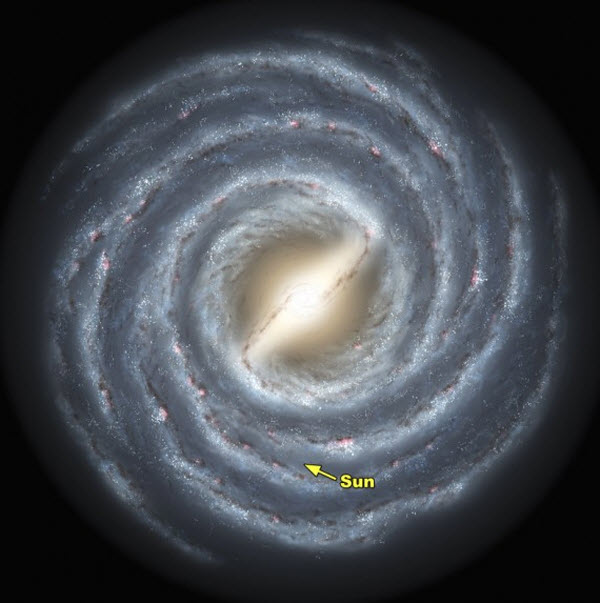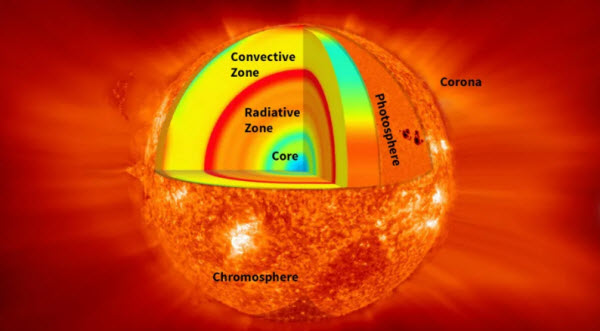The Sun is a yellow star approximately 4.5 billion years old, consisting of a hot, glowing sphere primarily made of hydrogen and helium. Located at the center of our solar system, its gravitational pull is responsible for the structure of this system, causing everything from the largest planets to the smallest pieces of space debris to orbit it. The Sun is about 150 million kilometers from Earth and is the only star in the solar system. It is crucial for life on our planet, as its energy is essential for the existence of life as we know it. Despite being the largest object in our solar system, the Sun is considered a medium-sized star compared to others in our Milky Way galaxy and beyond, where some stars are up to 100 times larger.
As a fiery body, the Sun’s hottest regions are found in its core, where temperatures reach up to 15 million degrees Celsius. The outer layer, known as the photosphere, is relatively cooler with temperatures around 5500 degrees Celsius. One of the Sun’s greatest mysteries is that its outer atmosphere, the corona, becomes hotter as it moves away from the photosphere, reaching temperatures of up to 2 million degrees Celsius.
The Sun accounts for more than 99% of the total mass in our solar system. Its immense impact on Earth has been recognized since prehistoric times, leading to its worship as a deity in various cultures. Despite its long lifespan, it is expected to continue for another five billion years. As hydrogen fusion in its core diminishes, the Sun will eventually experience a significant increase in temperature and core density, turning into a red giant that may engulf the orbits of Mercury and Venus, and possibly Earth, making it uninhabitable. Unlike planets, the Sun does not have moons, but it has planets with their own moons orbiting it.
Size and Distance of the Sun

The Sun is a medium-sized star with a diameter of about 700,000 kilometers. Despite its size, many stars are significantly larger. It would take over 330,000 Earth-sized planets to match the Sun’s mass and about 1.3 million Earths to fill its volume. The Sun is approximately 150 million kilometers from Earth, which is equivalent to one astronomical unit (AU). The closest star system to us is Alpha Centauri, a triple star system consisting of Proxima Centauri, a red dwarf located 4.24 light-years away, and Alpha Centauri A and B, sun-like stars orbiting each other at a distance of 4.37 light-years (a light-year is the distance light travels in one year, about 9.5 trillion kilometers).
Orbit and Rotation

The Sun resides in the Milky Way galaxy in a spiral arm known as the “Orion Arm,” extending outward from the Sagittarius Arm. It orbits the galactic center, carrying the entire solar system—planets, asteroids, comets, and other bodies—at an average speed of about 720,000 kilometers per hour. Despite this incredible speed, it takes roughly 230 million years for the Sun to complete one orbit around the galaxy.
As it orbits the galaxy, the Sun also rotates on its axis at an angle of 7.25 degrees. Being a gaseous body, different parts of the Sun rotate at different rates. At the equator, the Sun completes one rotation approximately every 25 Earth days, while at the poles, it takes about 36 days.
Formation of the Sun

The Sun formed about 4.6 billion years ago from a massive cloud of gas and dust called the solar nebula. As this nebula collapsed under its gravity, it began to spin faster and flattened into a disk. Most of the material was pulled toward the center, forming the Sun, which now contains 99.8% of the solar system’s mass. The remaining material formed the planets and other objects orbiting the Sun.
Larger stars burn their hydrogen fuel faster than smaller ones. For example, some stars with 40 times the Sun’s mass have lifespans of only a million years, whereas the Sun’s main sequence lifespan is about 10 billion years.
Structure of the Sun
The Sun is a massive sphere composed of approximately 73% hydrogen, 25% helium, and 2% metals, held together by its gravity. It is divided into several layers: the core, radiative zone, and convective zone. The next layer is the photosphere, the visible surface of the Sun, followed by the chromosphere, the transition region, and finally the corona, the Sun’s outer, expansive atmosphere.
Material leaving the corona at supersonic speeds forms what is known as the “solar wind,” creating a massive magnetic bubble around the Sun called the “heliosphere,” extending beyond the planets’ orbits. Earth lies within this heliosphere, with interstellar space lying beyond it.
The Sun’s core is the hottest part, where nuclear fusion occurs, converting hydrogen into helium and releasing tremendous light and thermal energy, reaching temperatures of 15 million degrees Celsius. The core’s energy moves outward through radiation, taking about 170,000 years to reach the convective zone, where it cools to less than 2 million degrees Celsius. Large plasma bubbles rise from the convective zone to the photosphere, which we perceive as the Sun’s surface.

The photosphere is not solid like Earth and other rocky planets. It is the layer that emits the most visible light and has a thickness of about 403 kilometers with temperatures around 5500 degrees Celsius. Although cooler than the core, it is still hot enough to form carbon compounds such as diamonds and graphite. Most of the Sun’s radiation escapes into space from the photosphere.
Above the photosphere are the chromosphere, transition region, and corona. The transition region is not always considered a distinct layer as it is a thin layer where the chromosphere rapidly heats up to become the corona. The photosphere, chromosphere, and corona are parts of the Sun’s atmosphere, with the corona being the uppermost layer. During a total solar eclipse, when the Moon covers the photosphere, the chromosphere appears as a thin red rim around the Sun, while the corona forms a white crown with plasma streamers extending outward.
One of the Sun’s greatest mysteries is why the corona is hotter than the layers below it—a puzzle that remains unsolved in solar studies.
Magnetic Field

The Sun generates magnetic fields that extend into space and between planets, conveyed by solar wind—streams of electrically charged gases flowing from the Sun in all directions. The Sun’s magnetic field varies over time in a cycle known as the solar cycle, which occurs approximately every 11 years. During this cycle, the Sun’s magnetic poles reverse, causing changes in the photosphere, chromosphere, and corona from stable to unstable states. This instability can lead to solar storms, flares, and coronal mass ejections. The last solar cycle began on December 25, 2019.
Solar activity can release enormous amounts of energy and particles that can impact Earth, affecting satellites, GPS systems, and radio communications, and potentially disrupting power grids and corroding pipelines. The most powerful recorded geomagnetic storm was the “Carrington Event” of September 1, 1859, named after British astronomer Richard Carrington. It affected telegraph lines and caused the aurora borealis to be visible across the world, including as far south as Cuba, the Bahamas, Jamaica, El Salvador, and Hawaii. Another solar explosion on March 13, 1989, caused geomagnetic storms that disrupted power transmission in Canada, plunging 6 million people into darkness for 9 hours. A solar flare in December 2005 caused X-ray radiation that interrupted satellite communications and GPS signals for about 10 minutes.
Can Life Exist on the Sun?
Life as we know it cannot exist on the Sun due to its extreme temperatures and harmful radiation. However, life on Earth depends on the Sun’s light and energy for processes such as photosynthesis, which is crucial for our food supply. Additionally, the Sun’s rays provide Vitamin D, essential for bone growth, and warmth for colder regions.
Spacecraft Studying the Sun

NASA and other international space agencies monitor the Sun continuously with a fleet of solar observatories. The Parker Solar Probe, launched on August 12, 2018, is studying the Sun from closer than any previous spacecraft. On December 14, 2021, NASA announced that Parker had flown through the Sun’s upper atmosphere, the corona, taking samples of particles and magnetic fields. This was the first time a spacecraft had touched the Sun.
On February 9, 2020, the Solar Orbiter was launched as a joint mission between the European Space Agency (ESA) and NASA to gather data on how the Sun influences the constantly changing space environment of the solar system. Other active solar missions include SOHO, ACE, IRIS, WIND, Hinode, and STEREO.
